Content is from Kirkbride et al. 2006Kirkbride et al. 2006:
Kirkbride JH, Jr, Gunn CR, and Dallwitz MJ. 2006. Family guide for fruits and seeds, vers. 1.0. Accessed September 2020-January 2022. URL: https://nt.ars-grin.gov/seedsfruits/keys/frsdfam/index.cfm ., without modification.
Updates are forthcoming.
Fruits: Pistil(s) compound; 1; 1-pistillate; with carpels united. Fruit pericarpium; simple; drupedrupe:
(indehiscent drupe) a fleshy, indehiscent fruit with one more hard pits enclosing seeds, derived from single, superior, simple or compound ovary; (dehiscent drupe) a fruit with a dry or fibrous to fleshy or leathery outer husk that early to tardily breaks apart (or opens), exposing one or more nutlike pits enclosing the seeds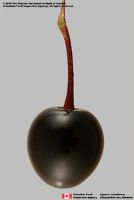 (not Spjut); without persistent central column; crowned by stigmastigma:
(not Spjut); without persistent central column; crowned by stigmastigma:
the portion of the pistil receptive to pollen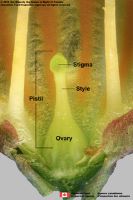 ; without stylestyle:
; without stylestyle:
in a flower, the narrow and elongated part of the pistil between the stigma and the ovary; sometimes persisting in fruit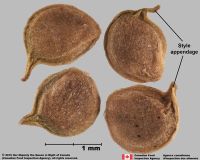 or stylar remnantsstyle base:
or stylar remnantsstyle base:
remnant of a style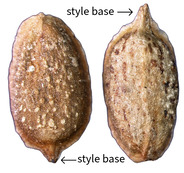 , or with styles(s); at apexapex:
, or with styles(s); at apexapex:
the point farthest from the point of attachment, or the "tip" of an organ ; not within accessory organ(s); 1-seeded; 1-seeded; less than 1 cm long to from 5.1–10 cm long; 0.6–5.5 cm long; without sterilesterile:
; not within accessory organ(s); 1-seeded; 1-seeded; less than 1 cm long to from 5.1–10 cm long; 0.6–5.5 cm long; without sterilesterile:
lacking male and/or female reproductive parts; also, not producing fruit or seed
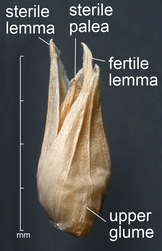 carpels; with fleshy laterallateral:
carpels; with fleshy laterallateral:
(of embryo) embryo lies along the side of the seed, generally towards one end; of, at, or from the side; in grasses, can refer to the sides adjacent to the dorsal and ventral sides
appendage, or without fleshy laterallateral:
(of embryo) embryo lies along the side of the seed, generally towards one end; of, at, or from the side; in grasses, can refer to the sides adjacent to the dorsal and ventral sides
appendage; not sulcatesulcate:
surface relief—having one or more elongate, relatively narrow and shallow depressions or grooves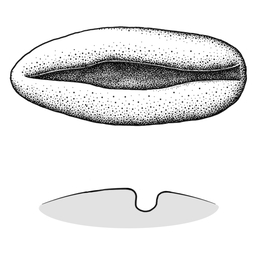 ; in transection tereteterete:
; in transection tereteterete:
approximately circular in cross section; width and thickness approximately equal
 , or compressedcompressed:
, or compressedcompressed:
flattened; in grasses, used to denote compression (not necessarily flattened) either laterally or dorsiventrally
; apexapex:
the point farthest from the point of attachment, or the "tip" of an organ beaked, or not beaked; apexapex:
beaked, or not beaked; apexapex:
the point farthest from the point of attachment, or the "tip" of an organ moderately beaked; indehiscentindehiscent:
moderately beaked; indehiscentindehiscent:
not opening on its own, as in a fruit
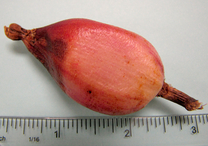 . Epicarpepicarp:
. Epicarpepicarp:
outer layer of fruit wall or pericarp, if divided into layers; note here used synonymously with exocarp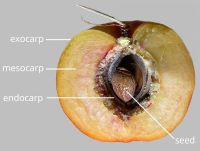 green, or pink, or purple, or red, or white, or yellow; shinyshiny:
green, or pink, or purple, or red, or white, or yellow; shinyshiny:
uniformly reflecting a high proportion of incident light at all angles , or dulldull:
, or dulldull:
reflecting only a low proportion of incident light, with no apparent sheen ; durable; without armature; without wing(s); without apicalapical:
; durable; without armature; without wing(s); without apicalapical:
at or pertaining to the end of the seed or fruit distal from its point of attachment (i.e., base)
respiratory hole. Endocarpendocarp:
the inner layer of the pericarp, if divided into layers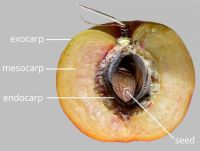 present; separating spontaneously from exocarpexocarp:
present; separating spontaneously from exocarpexocarp:
outer layer of fruit wall or pericarp, if divided into layers; note here used synonymously with epicarp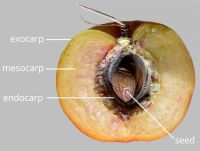 , or not separating from exocarpexocarp:
, or not separating from exocarpexocarp:
outer layer of fruit wall or pericarp, if divided into layers; note here used synonymously with epicarp ; coriaceouscoriaceous:
; coriaceouscoriaceous:
texture-leathery
, or crustaceouscrustaceous:
texture—thin, dry, indurate, and brittle
, or fibrousfibrous:
texture—long, flexible threads, thicker than hairs, that densely cover and obscure the surface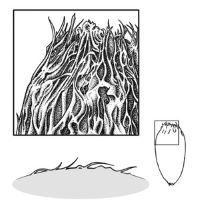 , or thin, or hard, or woodywoody:
, or thin, or hard, or woodywoody:
texture—consisting mainly of indurate lignified tissues, characteristic of or resembling wood
; not splitting into 1-seeded pyrenes; stone unilocular; not smooth; with longitudinally ridges, or fibers, or ribs; without wing; without operculumoperculum:
a dehiscent cap (or lid) of a seed or fruit that opens during germination or dehiscence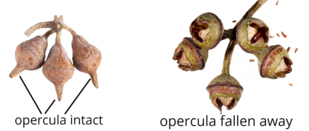 ; without secretory cavities; without longitudinallongitudinal:
; without secretory cavities; without longitudinallongitudinal:
of or relating to length or the lengthwise dimension
ridges. Funiculusfuniculus:
(alt. funicle) stalk connecting the ovule (later seed) to the ovary (later fruit) placenta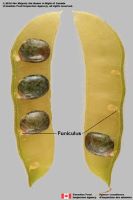 not persisting in fruit after seed shed.
not persisting in fruit after seed shed.
Seeds: Arilaril:
(broad sense) appendicular structure that wholly or partly envelops a seed and is produced from or a modification of the funicle, raphe, or outer integument; usually fleshy or pulpy, sometimes spongy or tufted-capillate, often brightly colored absent. Seed larger than minute; not bowl shaped; not nutlike; without winglike beakbeak:
absent. Seed larger than minute; not bowl shaped; not nutlike; without winglike beakbeak:
a usually firm, terminal appendage, sometimes tapered ; without caudatecaudate:
; without caudatecaudate:
tapering to a long, tail-like appendage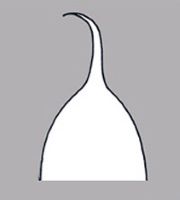 appendage(s); at maturity with food reserves; with endosperm; without canavanine. Sarcotestasarcotesta:
appendage(s); at maturity with food reserves; with endosperm; without canavanine. Sarcotestasarcotesta:
pulpy or fleshy outer layer of the seed coat, simulates aril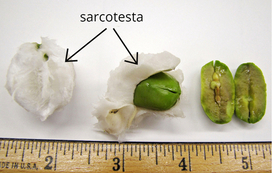 absent. Testatesta:
absent. Testatesta:
seed coat
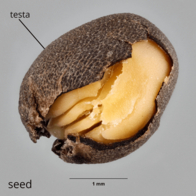 present; without pellicle layer; without fleshy or leatheryleathery:
present; without pellicle layer; without fleshy or leatheryleathery:
texture—moderately thick, tough, and very pliable
layer over hard layer; without crease or line separating cotyledons from hypocotyl-radicle; without notch along margin where cotyledons from hypocotyl-radicle tip approach each other; without glands; without bristles; glabrousglabrous:
without hairs
; without wings; without collar; without operculumoperculum:
a dehiscent cap (or lid) of a seed or fruit that opens during germination or dehiscence ; colored; monochrome; brown (all shades); thin; not becoming mucilaginousmucilaginous:
; colored; monochrome; brown (all shades); thin; not becoming mucilaginousmucilaginous:
resembling mucilage; moist and sticky
when wetted; surrounding endosperm. Endosperm development nuclear; copious; without fatty acid containing cyclopropene; without apicalapical:
at or pertaining to the end of the seed or fruit distal from its point of attachment (i.e., base)
lobes; without chlorophyll; without isodiametric faceted surface; without odor. Embryo differentiated from food reserve; well developed; 1 per seed; partially filling testatesta:
seed coat
 (with food reserve); 0.1 times the length of food reserve; at one end of seed not extending into a depression or cup; axileaxile:
(with food reserve); 0.1 times the length of food reserve; at one end of seed not extending into a depression or cup; axileaxile:
on or of the axis
and centric; straight; parallel to seed length; without coleorhiza; without simmondsin; without stomata; not green; with 2 or more cotyledons. Cotyledons 2; equal in size; not punctatepunctate:
surface relief - dotted with pits or with translucent, sunken glands or with colored dots, similar to pitted dotted.
dotted.
Literature specific to this family: Kårehed, J. 2001. Multiple origin of the tropical forest tree family Icacinaceae. Amer. J. Bot. 88:2259–2274; Villiers, J.-F. 1973. Icacinacées. In: A. Aubréville & J.-F. Leroy, eds., Flore du Cameroun, vol. 15, pp. 3–100; Guymer, G.P. 1984. Icacinaceae. In: A.S. George, ed., Flora of Australia, vol. 22, pp. 204–211. Australia Government Publishing Service, Canberra; Sleumer, H. 1972. Icacinaceae. In: C.G.G.J. van Steenis, ed., Flora malesiana, vol. 7, pp. 1–87. Noordhoff International Publishing, Leiden.
General references: Aubréville, A. & J.-F. Leroy. 1982. Flore de la Nouvelle Calédonie et Dépendances. National d'Historie Naturelle, Paris, Flora of Australia (various years & volumes). Australian Government Publication, Canberra, Steenis, C.G.G.J. van, ed. 1950 onwards. Flora Malesiana, ser. 1. Spermatophyta. Noordhoff-Kolff, Djakarta.